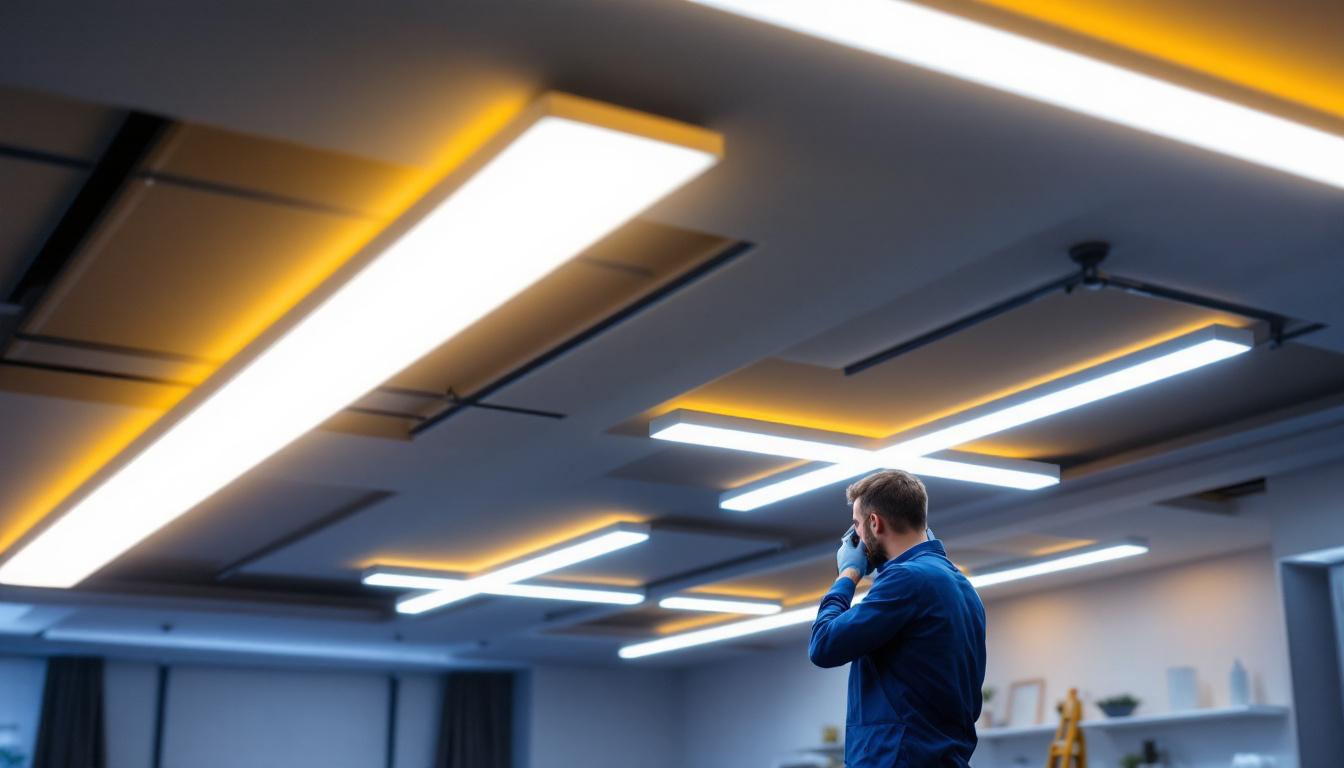
Lighting plays a crucial role in construction projects, impacting not only the quality of work but also the safety and efficiency of the job site. As a lighting contractor, mastering the nuances of construction lighting can set you apart from the competition. This article delves into essential tips and considerations for lighting contractors to enhance their expertise and deliver outstanding results.
Before diving into advanced techniques, it is vital to grasp the fundamental principles of construction lighting. Proper lighting is essential for visibility, safety, and productivity on the job site. Different areas of construction require varying lighting solutions, and understanding these needs is the first step toward effective lighting design.
Construction lighting primarily falls into three categories: general, task, and accent lighting. General lighting provides overall illumination, ensuring that the site is well-lit for safety. Task lighting, on the other hand, focuses on specific areas where detailed work is performed, such as during electrical installations or plumbing work. Accent lighting can be used to highlight features or areas of interest, although it is less common in construction settings.
Each type serves a unique purpose, and selecting the right combination is crucial for creating a functional and safe work environment. Understanding these categories helps contractors make informed decisions about the types of fixtures and placements needed for each project. For instance, portable floodlights may be used for general lighting in large outdoor areas, while LED work lights can provide focused illumination for intricate tasks. Furthermore, the strategic placement of lighting fixtures can significantly reduce shadows and glare, enhancing the overall safety and efficiency of the workspace.
Light quality is another critical aspect that contractors must consider. Factors such as color temperature, color rendering index (CRI), and brightness all contribute to the effectiveness of lighting. For instance, a higher CRI means that colors will appear more accurate under the light, which is essential for tasks requiring precision. Additionally, the color temperature can influence the mood and productivity of workers, with cooler temperatures often being more stimulating and warmer tones creating a more relaxed atmosphere.
Moreover, the choice of lighting technology—whether LED, fluorescent, or halogen—can impact energy efficiency and operational costs. LEDs, for example, not only provide excellent color rendering but also consume significantly less power and have a longer lifespan compared to traditional bulbs. This makes them an increasingly popular choice on construction sites, where energy consumption can be a major concern. Furthermore, the ability to dim or adjust the intensity of lighting can also enhance comfort and focus, allowing workers to adapt the environment to their specific needs throughout the day.
Effective lighting design requires careful planning and consideration of various factors. This stage is crucial for ensuring that the lighting meets the needs of the construction site and complies with safety regulations.
Every construction site is unique, which means that lighting needs can vary significantly from one project to another. Conducting a thorough assessment of the job site is essential. This includes evaluating the layout, the types of tasks being performed, and any potential hazards that may require special attention.
Taking measurements and noting the locations of obstacles or structures that may block light can help in determining the most effective placement for lighting fixtures. Additionally, understanding the workflow of the site can inform decisions on where task lighting is most needed.
Safety is paramount in construction, and lighting plays a significant role in maintaining a safe work environment. Familiarizing oneself with local safety regulations and standards is essential for lighting contractors. This includes understanding the minimum illumination levels required for different areas and tasks, as well as ensuring that all lighting equipment is compliant with safety codes.
Incorporating safety measures into the lighting design can help prevent accidents and injuries on the job site. This may involve using shatterproof fixtures, ensuring proper grounding of electrical equipment, and implementing emergency lighting solutions for power outages or other emergencies.
The selection of lighting fixtures is a critical component of any construction lighting plan. The right choice can enhance visibility, improve safety, and contribute to the overall efficiency of the project.
There are various types of lighting fixtures available, each with its own advantages and disadvantages. LED lights have become increasingly popular due to their energy efficiency, longevity, and low heat output. They are ideal for construction sites where lighting is needed for extended periods.
Halogen and incandescent lights are also options, but they tend to consume more energy and generate more heat, which can be a concern in enclosed spaces. Fluorescent lights offer a balance between energy efficiency and color rendering, making them suitable for general lighting in many scenarios.
Construction sites often require lighting solutions that are portable and adaptable. Work lights with adjustable stands or those that can be easily moved are essential for accommodating changing work conditions. Additionally, some projects may benefit from temporary lighting setups that can be repositioned as work progresses.
Investing in high-quality, portable lighting solutions can save time and effort, allowing contractors to focus on the tasks at hand rather than struggling with inadequate lighting.
As technology advances, smart lighting solutions are becoming more prevalent in construction. These systems offer enhanced control and efficiency, making them an attractive option for contractors.
Smart lighting systems can be programmed to adjust based on the time of day, occupancy, or specific tasks being performed. This not only improves energy efficiency but also enhances safety by ensuring that areas are adequately lit when needed.
Additionally, remote control capabilities allow contractors to manage lighting from a distance, making it easier to adapt to changing conditions on the job site. This level of control can lead to significant cost savings and improved productivity.
Integrating lighting systems with other construction technologies can further enhance efficiency. For example, linking lighting with security systems can ensure that areas are well-lit when motion is detected, providing an added layer of safety.
Furthermore, integrating lighting with project management tools can help contractors monitor energy usage and adjust lighting schedules based on project timelines. This holistic approach to construction management can lead to better resource allocation and improved project outcomes.
Once the lighting system is installed, ongoing maintenance and troubleshooting are crucial for ensuring optimal performance throughout the construction project.
Conducting regular inspections of lighting fixtures and systems can help identify potential issues before they escalate. This includes checking for damaged bulbs, loose connections, and signs of wear and tear. Keeping a maintenance schedule can ensure that all lighting remains functional and effective.
Additionally, training staff on how to recognize and report lighting issues can foster a proactive approach to maintenance. This collaborative effort can contribute to a safer and more efficient work environment.
Common lighting issues, such as flickering lights or inadequate illumination, can often be resolved with simple troubleshooting steps. For instance, flickering may be caused by a loose connection or a faulty bulb, while inadequate illumination may require repositioning fixtures or adding additional lighting sources.
Having a clear understanding of these common problems and their solutions can empower contractors to address issues quickly, minimizing disruptions to the workflow.
Effective communication with clients is essential for ensuring that their lighting needs are met and that expectations are aligned throughout the project.
Engaging with clients to understand their specific lighting requirements and preferences can lead to more successful outcomes. This may involve discussing the intended use of the space, aesthetic considerations, and any budget constraints.
By actively listening to clients and providing expert recommendations, contractors can build trust and foster positive relationships, ultimately leading to repeat business and referrals.
When presenting proposals for lighting solutions, clarity is key. Detailed proposals that outline the scope of work, types of fixtures, and associated costs can help clients make informed decisions. Including visual aids, such as diagrams or renderings, can further enhance understanding and facilitate discussions.
Transparency in communication not only helps manage client expectations but also reinforces the contractor’s professionalism and expertise in the field.
The lighting industry is constantly evolving, with new technologies and trends emerging regularly. Staying informed about these changes is crucial for lighting contractors looking to maintain a competitive edge.
Participating in workshops, webinars, and industry conferences can provide valuable insights into the latest lighting technologies and best practices. Many organizations offer certification programs that can enhance a contractor’s credentials and knowledge base.
Additionally, networking with other professionals in the field can lead to the exchange of ideas and experiences, fostering a culture of continuous improvement.
As sustainability becomes a priority in construction, lighting contractors must adapt to these trends. Incorporating energy-efficient solutions and environmentally friendly practices can not only meet client demands but also contribute to a more sustainable future.
Understanding the benefits of sustainable lighting options, such as solar-powered fixtures or smart controls, can position contractors as leaders in the industry, appealing to environmentally conscious clients.
Mastering the art of construction lighting requires a combination of technical knowledge, practical skills, and effective communication. By understanding the fundamentals of lighting design, selecting appropriate fixtures, implementing smart solutions, and maintaining open lines of communication with clients, lighting contractors can enhance their services and stand out in a competitive market.
Continuous education and adaptation to industry trends will further empower contractors to deliver exceptional results, ensuring that they remain at the forefront of the construction lighting field. With these tips in mind, lighting contractors can confidently approach each project, knowing they are equipped to meet the challenges of the ever-evolving construction landscape.
Ready to elevate your construction lighting game? At LumenWholesale, we provide you with the high-quality, spec-grade lighting products you need to outshine the competition. Our unbeatable wholesale prices mean you get the best value without the middleman markups. With our extensive selection that meets rigorous industry standards, you can trust that your projects will be lit reliably and efficiently. Plus, with free shipping on bulk orders, you can stock up on premium lighting without worrying about hidden fees. Don’t compromise on quality or cost—discover wholesale lighting at the best value today and light up your construction sites with confidence.

Discover the answers to lighting contractors’ most pressing questions about Rab LED lighting.

Discover how ceiling strip LED lights are revolutionizing the lighting industry for contractors.

Explore the profitability of HID lamps versus LED lighting in installations.

Discover the essential guide to track lighting track types and their significance for lighting contractors.